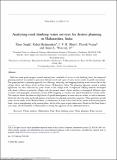| dc.contributor.author | Singh, Ranu | |
| dc.contributor.author | Brahmankar, Rahul | |
| dc.contributor.author | Murty, J. V. R. | |
| dc.contributor.author | Verma, Piyush | |
| dc.contributor.author | Wescoat, James | |
| dc.date.accessioned | 2020-06-02T17:54:54Z | |
| dc.date.available | 2020-06-02T17:54:54Z | |
| dc.date.issued | 2019-11 | |
| dc.date.submitted | 2019-10 | |
| dc.identifier.issn | 1366-7017 | |
| dc.identifier.issn | 1996-9759 | |
| dc.identifier.uri | https://hdl.handle.net/1721.1/125623 | |
| dc.description.abstract | India has made good progress toward meeting basic standards of access to safe drinking water, but improved planning methods are needed to prioritize different levels and types of water service needs for public investment. This paper presents a planning approach for collecting, analyzing, and mapping drinking water service data at the village, block, and district levels in Pune district, Maharashtra, India. The planning approach created a mobile application for data collection by gram sevaks at the village level. It employed ranking methods developed with district officers to prioritize villages with the greatest needs, cluster analysis to distinguish different types of needs, and geographic information system (GIS) mapping to visualize the spatial distribution of those needs. This analysis shows that there are high levels of spatial heterogeneity in water services within, as well as between, blocks but also that there are broad patterns of priorities for planning and policy purposes. These priorities include water service needs in the Western Ghats, a combination of water source and service needs in dissected plateau lands, source strengthening in the eastern plains, and local hot spots in peri-urban areas. Based on this Pune district case study, the Government of Maharashtra is testing the approach in five additional districts. | en_US |
| dc.language.iso | en | |
| dc.publisher | IWA Publishing | en_US |
| dc.relation.isversionof | http://dx.doi.org/10.2166/wp.2019.086 | en_US |
| dc.rights | Creative Commons Attribution-NonCommercial-NoDerivs License | en_US |
| dc.rights.uri | http://creativecommons.org/licenses/by-nc-nd/4.0/ | en_US |
| dc.source | IWA Publishing | en_US |
| dc.title | Analyzing rural drinking water services for district planning in Maharashtra, India | en_US |
| dc.type | Article | en_US |
| dc.identifier.citation | Singh, Ranul, et al. "Analyzing rural drinking water services for district planning in Maharashtra, India." Water Policy, 22, 1 (2020): 37-51. © 2020 The Authors. | en_US |
| dc.contributor.department | Massachusetts Institute of Technology. Department of Architecture | en_US |
| dc.relation.journal | Water Policy | en_US |
| dc.eprint.version | Final published version | en_US |
| dc.type.uri | http://purl.org/eprint/type/JournalArticle | en_US |
| eprint.status | http://purl.org/eprint/status/PeerReviewed | en_US |
| dc.date.updated | 2020-03-30T13:55:18Z | |
| dspace.date.submission | 2020-03-30T13:55:20Z | |
| mit.journal.volume | 22 | en_US |
| mit.journal.issue | 1 | en_US |
| mit.license | PUBLISHER_CC | |
| mit.metadata.status | Complete | |
